2019
We’ve had a fabulous start to our reading programme for 2019. In our first week, we’ve practised ‘read to self’ and ‘listen to reading’ using our Year 2 iPads.
Read to Self

We’ve been learning how to choose ‘good fit books‘ for our book boxes and we’ve made some great choices.
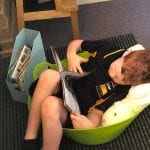
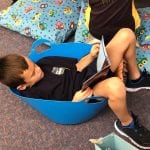
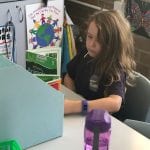
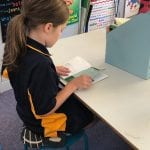
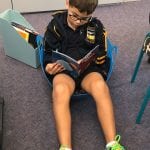
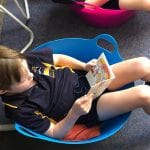
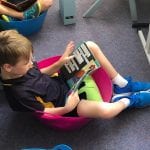
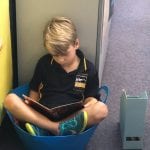

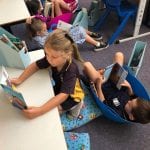
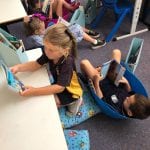
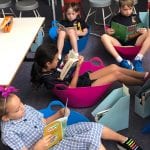
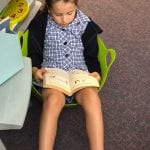
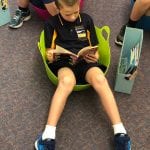
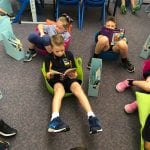
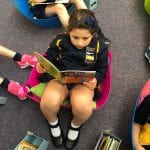
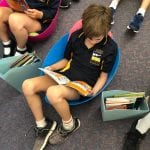
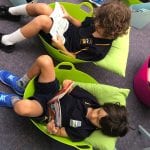
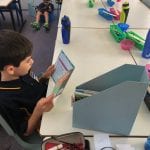
Listen to Reading
We used our class iPads to listen to different stories via Ziptales and Sunshine online. We loved listening to the expression of people reading the stories to us, as we followed the words on each page. Then we did a quiz for each story after we’d listened to it to check our comprehension.
2018
We have loved using the Daily 5 reading cafe menu to develop our reading skills. Every week we practise:
- read to self
- listen to reading
- partner reading.
We have made lots of progress with our reading skills – we read with lots of expression, greater fluency and always make sure we understand what we’re reading. We LOVE adding to our book boxes – we have some levelled readers, plus our choice of fiction and non fiction books from the class and school library.
We’re a lot more confident when using iPads to listen to reading. Our favourite sites are Sunshine Online and Zitpales.
We love to use our whisper phones during partner reading sessions BUT we really need to make sure we whisper for reading! It’s great to hear our own voices through the whisper phones.
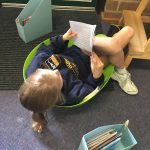
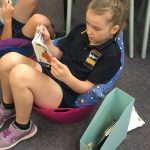
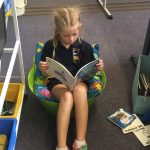

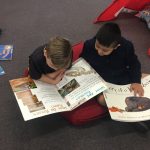
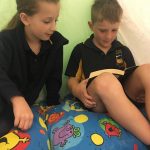
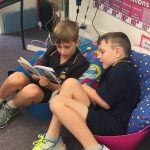

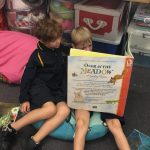
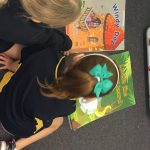

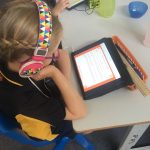



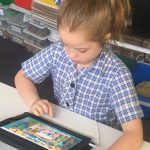
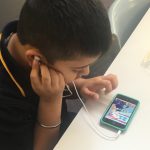
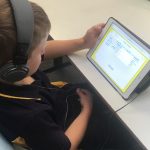
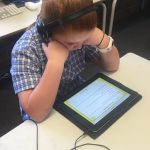



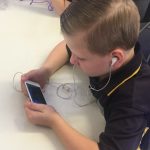
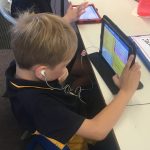

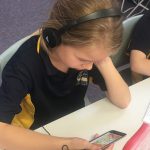
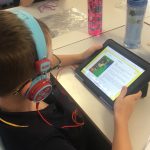
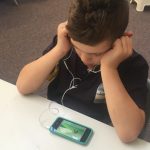
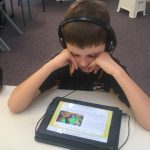
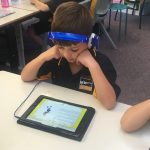
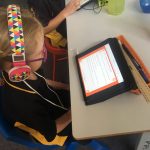
2017
Word Work, Listen to Reading, Read to Self and Partner Reading
Here are lots of photos showing us hard at work on our different learning tasks. On Thursdays we choose to practise either Spelling or Reading first and then we swap over. This gives our class members an opportunity to manage our own learning and think for ourselves. We’ve loved the variety of activities that we complete in this time.
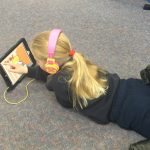
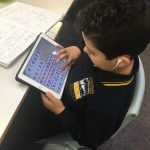
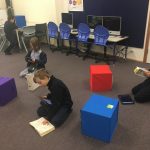
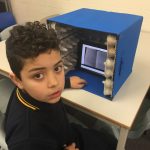
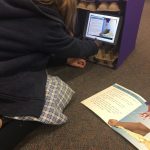
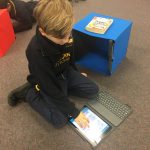
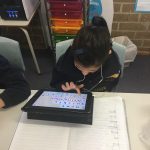
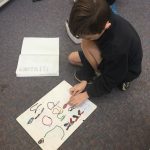
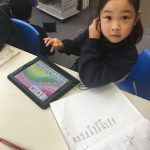

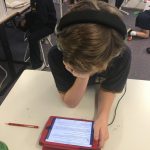

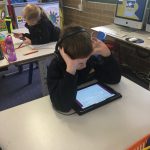
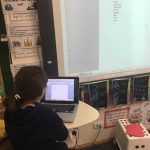
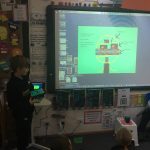
Last week our Sharing Time topic was to bring along a picture book to read to a small group of our classmates. We had a huge variety of books brought in from home and some from our school library. It’s always interesting to see the books that are chosen.
Here’s some photos from our reading sessions last week:
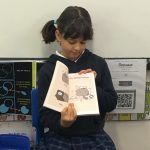
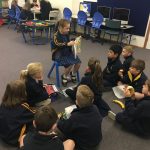
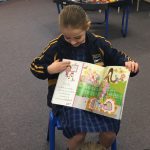
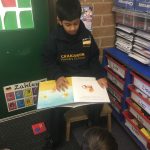
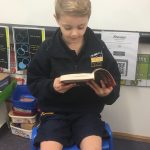
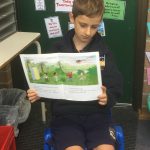
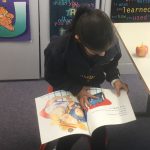
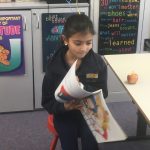
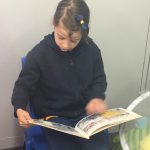
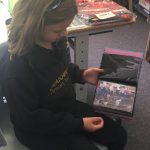

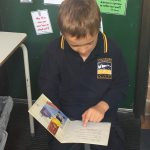

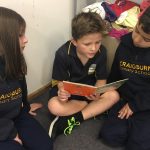
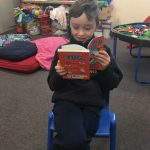

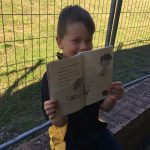
2016
Our class has been developing our reading skills using the Daily 5 CAFE program to help us.
On different days of the week we do:
- read to self
- partner reading
- listen to reading.
Every Tuesday we use our iPads and iPods to listen to stories being read to us. We use different apps to listen to stories or we use the Ziptales website – we LOVE this site as there are lots of different books for different levels of reading skills. There’s a good fit book on the site for our entire class.
Here’s photos from today’s session.
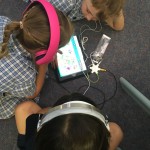
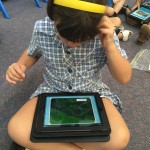
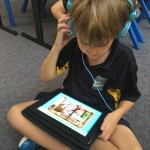
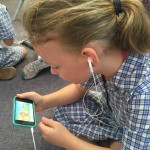
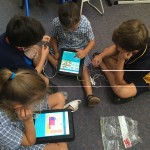
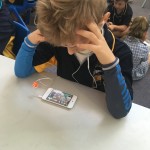
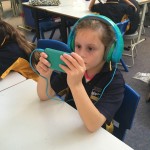
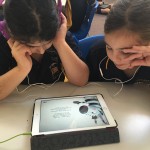
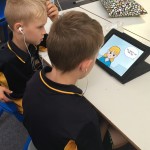
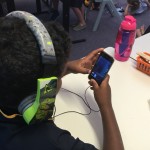
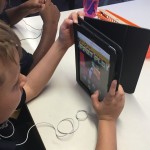
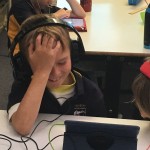
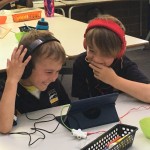
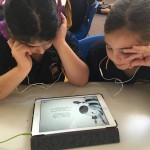
2015
Term 4
A perfect day for a reading picnic!
Last Monday our class headed outside for a reading picnic. It was such a lovely Spring morning that we took our picnic blankets and chairs outside to do ‘read to self.’
Term 3 – Deep reading time
Today we changed our partner reading session – just to keep things interesting!
We used our non0-fiction texts that relate to our inquiry unit about livings things – their needs and what our responsibilities are in looking after them.
We looked for the different features of a non fiction text:
We LOVED reading with our partners and learning so much new information about living things, plants and their needs. So many of our questions from the Wondering Wall were answered -as well as had us thinking about new questions to add.
We really enjoyed using non fiction texts for partner reading and we LOVED having a long reading session to really take time to read different texts.
Term 1
CAFE Menu
As we continue to develop our reading skills we added 4 more strategies to our Daily 5 Cafe board.
We are using these skills really well every time we read:
- Make a mental picture or images.
- Use the pictures. Do the words and pictures match.
- Back up and reread.
- Predict what will happen next, use the text to confirm.
Then we added 4 new skills that we’ll be developing in whole class reading sessions, read to self, partner reading and listening to reading activities.
Each year we use the Daily 5 CAFE menu to help us develop our reading skills. CAFE is an acronym for Comprehension, Accuracy, Fluency and Expand vocabulary. All of these areas of reading are extremely important and good readers know they need to read regularly to improve their skills.
We have a CAFE Menu in our classroom. At the end of each week we put a strategy card on the menu.
At the beginning of the year this is what our CAFE Menu looks like.
In our first week we were checking for understanding of the texts we were reading.
We made sure we were reading “Good fit books’ in week 2 of practising.
This week we were creating a mental image for the words we were reading in our ‘Good fit books’.
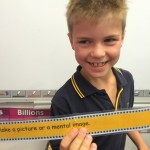
We’ve started the year off with 3 new reading skills that we’re learning about and practising every time we read.
Listen to Reading
This week we started the third part of Daily 5 reading strategies – listen to reading. We use our iPads and iPods to listen to stories from the different apps we’ve downloaded onto the devices. Most of us have our own earphones to help keep the noise down and we use rockstars so that more than 1 person can use each device.
This week we started Partner Reading as a part of our Daily 5 learning. We were quick to choose a partner, select our good fit books and get settled into our reading. We did a great job at coaching each other as we read – helping each other with unfamiliar words and asking questions as we read.
We made sure we were using EEKK (elbow to elbow and knee to knee) and using our whisper voices so we didn’t interrupt others reading nearby.
We’ve had a wonderful start to our Daily 5 Read to self strategy. We’ve already made it to 25minutes of reading – we’ve shown great stamina! We LOVE our buckets – they’re so comfy for reading!
2014
Term 4
Today our class went on a reading picnic. It was such a lovely day outside we decided to read outside and enjoy the warm weather. We packed our picnic blankets, book boxes, chairs and pillows. We went out to the oval and sat under the shade of the big gum tree and got into our reading.
We did read to self or read with a partner and loved our reading picnic.
Here’s the photos from our picnic.
Apps in our learning
We use iPods, iPads, laptops and desktop computers as a part of our learning. We use many different apps in our learning every day. We love to experiment with a variety of apps but also have lots of favourites.
During our Daily 5 reading activities we use regularly use:
Storychimes, Explain Everything, Rumble in the Jungle, The Very Cranky Bear, Hairy Maclary from Donaldson’s Dairy, Hairy Maclary’s Bone, The Wrong Book, ABC Mouse, Lulu Australia, Hairy Maclary.
We also have different websites that we like to use to listen to reading. These are listed on the apps/ sites page of our blog.
We love to listen to the stories being read to us (for Listen to Reading) and we also use them to record ourselves reading the story (practising our Daily 5 reading skills, e.g. using expression in reading). The apps we use have different options for us to choose from – depending on which skills we are focussing on. We also use them to practise the reading skills we have already learnt.
Whole class reading task – using air server to project a storybook onto the IWB.
Individual and partner reading tasks.
We also use iPad/ iPod apps to in our Word Word (to practise our spelling words). We all complete a variety of spelling tasks and we love to use different apps to help us learn our words.
The apps we regularly use are: Wurdle, Word Cloud, Magnetic ABC, Explain Everything, Word Ball, Word Wizard, Rocket Speller, Scribblify and Etch Sketch.
We use these to write our words, type our words, hear our words and letter blends and publish our learning.
Term 3
Maths games
We’ve been using a variety of maths games to develop our mental computation skills and to gain more automaticity of numbers during problem solving tasks. These games have come from Miss Sporn’s PD with Michael Ymer.
Total Recall- Choosing and using operations:
A game suitable for students from Prep to Year 6.
Children play game in pairs. All picture cards removed leaving numbers 1 – 10 and jokers.
Place 6 cards face up on a grip mat so they don’t slide. The remainder of the deck kept together face down. Students take it in turn rolling a ten sided dice [ Can use a six sided dice ]. Using the number that is displayed the student is challenged to use combinations of [ 1, 2 or 3 cards ] cards to equal the number. Cards used to make the answer are collected and kept by each student and then replaced from the deck. The game continues until all cards have been used. Young children will use addition / subtraction to make answers using two cards. Older or more able students can use any combination of operations, decimals, negative numbers, fractions, order of operations etc and use up to five cards. Students need to articulate how they make the answer, trying to gather more cards than their partner. Once all cards are gone students toal all card numbers to see who wins.
Making Tens – Addition, extension to other operations:
A game suitable for students from Prep to Year 6.
Children play game in pairs. All picture cards and tens removed leaving numbers 1 – 9. Place 9 cards face up in three rows of three similar to the channel 9 logo on TV. The remainder of the deck are placed on top of the cards face up until all are gone leaving the nine piles of cards.
Students take it in turns collecting two cards that when added together make ten. This continues until all cards are removed. Children need to say aloud the combinations as they collect the pairs.
Variations
Collect more than two cards to make ten, use subtraction and addition, roll a dice and use the number displayed as the target instead of ten, make 100 using the displayed cards as two digit numbers, create equations to make 100 using any operation, make 10 using mixed numbers eg. 4.7 + 5.3, make 1 using decimals eg. 0.46 + 0.54.
Cover Up – Choosing and using operations:
A game suitable for students from Year 1 to Year 6.
Children play the game in pairs. A deck of cards with all pictures removed. Game board with the numbers 0 -20 displayed in a grid.
Each child has 7 counters of the same colour. Their partner has a different colour.
Children take it in turns taking two cards at a time from the top of the deck and add or subtract the numbers to make an answer from 0 – 20. One of their seven counters is placed on that number. The objective is to get rid of all counters first. If a student lands on top of number that has their partner’s counter on it they take the place and send the counter back to their partner. Students can have more than one counter of their own on the same number but if their opponent lands on that number all counters are sent back.
Variations….use three cards, use dice instead of cards, allow any operation, simplify the game by using a 0 – 12 board and a cards 1 to 6 or a six sided dice.
100 or Bust!:
Introduction / objectives
This is a card game that provides the students with the opportunity to investigate a variety of mental computation strategies when adding and multiplying numbers. It is quick and easy to organise and is lots of fun, even for adults who play it. The less able student can win, as there is an element of chance involved. A terrific number sense game to use as a warm up activity, or a focus lesson for young children.
Equipment [for each pair of students]
100 number board, 10 x 10 tables chart and two counters.
Deck of cards. All number cards have face value. Ace = 1. 2 = 2 etc.
Picture cards = 10
Joker = wild [can have the value of any other card in the deck].
| 1 | 2 | 3 | 4 | 5 | 6 | 7 | 8 | 9 | 10 |
| 11 | 12 | 13 | 14 | 15 | 16 | 17 | 18 | 19 | 20 |
| 21 | 22 | 23 | 24 | 25 | 26 | 27 | 28 | 29 | 30 |
Procedure
Two students compete against each other to see who can get closest to 100 without busting. One student deals cards out to his/her opponent who adds or multiplies the cards. This continues until the student decides to stop.
Example Player A is going first and having cards dealt by partner.
Card 5 is dealt first so player A moves counter to 5 on number board. Card 6 is the next card dealt. This could be 5+6 and the counter is moved to 11 or it could be 5×6 and counter is moved to 30. Let’s assume that Player A decides to move to 30. The next card is a KING so the student adds 10 and moves the counter to 40. Next card is 2. Student decides to multiply and moves to 80. Next card is Ace. Student decides to multiply and stay on 80, hoping that the next two cards are 10’s and he/she can hit exactly 100. Next card is a 5. Student adds and moves to 85. Next card is 9. Student moves to 94 and decides to stop fearing that the next card flipped will be bigger than a 6and she / he would bust.
Player B now has the cards dealt to him / her and tries to better 94 without busting. Once this game is completed, play again but player B goes first.
Teacher tips
- Card familiarisation activities are a good idea if students haven’t been exposed to decks of cards before. Perhaps alder students could tell you the value of a deck of cards based on the values listed in this game. Younger students should do sorting activities to help them discover that there are four of each card. How many cards in the deck?
- Transparent counters help students see the numbers on the board.
- Children find shuffling cards difficult so keep working through the deck of cards until you run out. Then shuffle or ask the teacher to help.
- Children only deal a card out when the partner says, ‘Card please ‘. This eliminates the problem of students dealing the card while the other student is still deciding their move. If the card is flipped without being asked for the receiver has the option of using it or having a fresh one dealt out.
- Try modelling the game to students using an overhead, transparency of 100 number board, transparent counters and overhead miniature playing cards. A very effective way to demonstrate the game and strategies that you need to discuss.
- Vary the game if needed. Perhaps only add for young children or play hit exactly 100 for older students. For this game students can use any operation with winner being the student who hits 100 in the least amount of cards.
- Vary the game by making it more challenging. Use any operation to hit exactly 100 in fewer cards than your partner.
- When introducing the game, tell the children that while the game is lots of fun, the point of the game is to make decisions and become a smarter mathematician by taking short cuts when adding or multiplying. The overhead gives you the opportunity to discuss some of the strategies listed later in the article.
Term 2
Partner Reading
Our Daily 5 learning journey continues. We love our partner reading sessions! We love to listen to each read, listen to the expression that is used when partners are reading aloud, give coaching tips if needed and even reading to the whole class.
Here’s some photos of our latest partner reading session.
Today we did a quick mental maths session around division and we used different strategies to work our out ‘problems’. We realised that we use lots of different strategies to find an answer. We are focussing on understanding what division means and ways that we can solve different problems that include using division. Here’s some photos from today’s session.
Looking at each photo can you see what strategies the children were using to solve their problems?
Term 1
Work Work
This term we’ve loved learning our new words each week. We practise learning our words in lots of different ways, like:
* writing them in syllables
* writing them into interesting sentences
* making them with plasticene
* writing them on whiteboards
* writing them with buttons or wikistix
* writing them outside on the concrete with chalk
* finding out the meaning of each word using dictionaries
and lots of different other ways.
Can you give us any suggestions for other ways we could practise our words during word work tasks?
Term 4 – Week 7
During this year we’ve been working really hard to develop our problem solving skills. So here’s a challenge from the Ann & Johnny Natural Maths site. Can you solve the problem – bring your ideas in to share with the class. This is also a great problem to solve as we have Gala Day at Craigburn on Monday – lots of stalls selling or running games as a whole school fundraiser. Some of the girls in our class happen to be running a cup cake stall!
Term 4 – Week 3
Daily 5 Reading
During this year we’ve been working on developing our reading stamina. This is a time when each class member needs to focus on reading their ‘good fit books’ for a period of time, without being distracted or losing focus. We’ve been timing ourselves and plotting our stamina progress on our Daily 5 Stamina graphs.
Our best reading stamina time is 33 minutes – for the whole class. That’s an amazing amount of time to remain focussed. It’s a great help that all of the children in our class choose ‘great fit books’ that are really interesting. We usually need to stop reading to move onto different activities like word work.
Here’s some photos from this weeks loooooong reading session. Great reading everyone!
TERM 3
Week 4
Today we began learning about many different parts of time. We will be investigating:
- learning times on analogue and digital clocks, eg o’clock, 1/2 past, 1/4 past/to and minute intervals
- elapsed periods of time
- adding time on
- recognising times that are important to us.
We are going to be using the following sites to support our learning.
Matching analogue and digital times on the clocks. – Stop the Clock.
In this game you need to match the digital time with the time displayed – On Time!
Tell us about your favourite time of day and what you do then. Can you list some time words we begun to focus on?
Week 4
Conjunctions
We are having a major focus on improving our use of conjunctions in our writing.
Here are some websites to help practise our use of conjunctions.
Have fun playing these games and I look forward to you using the new conjunctions in your daily writing activities.
Week 1: Daily 5 Reading Session
This week we got back into our fantastic Daily 5 reading routines.
Each day we prastised:
- read to self
- read to someone
- listen to reading.
Here are some photos of our class members reading to themselves or listening to reading using the iPads or iPods in our class. Many of the apps we use are listed on our blog under class sites and apps. We love lots of our reading apps and really enjoy listening to the many stories on there.
Here are some photos from our session on Thursday.
Daily 5 Reading on PhotoPeach
Sharing Time Topic
Bring Your Favourite Book to Share
As a part of our Sharing Time topic last week, we were asked to bring along our favourite book to share with the class.
We had lots of different books that were all “good fit” books – a good fit books suits your reading level and skills. We’ve learned about good fit books from our Daily 5 Cafe learning. It was a bit like our book sales – for our sales we bring along books to recommend to other readers. They might like the sound of the stories/ series of books and we love to share our books – we all love to read!!
Here are some photos of our sharing time sessions last week. Each person who brought a book had a small group of children to share their story / stories with. We had lots of fun sharing and learning about each others books.
Sharing Time – Favourite Books on PhotoPeach
Daily 5
Partner Reading
Tyla and Ava loved their partner reading session today. They each had a copy of the same books and took turns at reading and listening to each other. They practised so that they can read the books to the rest of the class too.
Book Reccomendations
Ethan, George and Arman would like to recommend some books for others to try reading. Each of them is loving these books that they are reading and thought you might like to try them too.
Read to Self
As a part of our daily reading activities this person chose Read to Self and she chose a big book! Can you tell who’s reading the book called No Queen Today by Jill Eggleton?
Listen to Reading
Last week we had our first Listen to Reading session. We’ve been practising Read to Self and Read with Someone lots and have really learned a lot from our reading activities. Last Friday we used our Interactive Whiteboard, the Apple computers, iPads and iPods to listen to different stories. We loved listening to lots of different types of stories and looking at the pictures to see if they matched the text. Our blog page lists the apps we used on our devices to listen to stories and it also has some of the websites that we used. Some people also used rockstars so that more than one person could listen with each device. Nearly our whole class has their own ear phones in their book box.
Here’s some photos from our session – we’re really looking forward to our next Listen to Reading session.
Listen to Reading on PhotoPeach
Mathematics
Place Value
We’ve been investigating place value in our Maths activities. Place value tells us the value of each digit in a number.
For example: in 589 – there are 5 groups of 100 = 500, 8 groups of 10+80 and 9 units/ones.
Here are some photos of one of our sessions using MAB equipment – we’ve had lots of fun learning about place value.
Mathematics – Place Value on PhotoPeach
Here’s a great website with different games to help you practise your place value skills.
Daily 5 – Read to Someone
Today we had our second session of Reading to Someone. We made sure that everyone understood EEKK (elbow to elbow or knee to knee) and had plenty of ‘good fit’ reading materials with us. We got settled into our reading spots – where we’re comfortable- and settled down for a really interesting reading session.
Here’s some photos of today’s Read to Someone session.
Daily 5 – Read to Self
Today we started our very first Daily 5 Reading session. We have filled our book boxes with “good fit” books and discussed the 3 ways to read a book:
- Read the pictures
- Read the words
- Retell the story.
Miss Sporn challenged us that we needed to try and stay focussed on our own reading. We needed our book boxes next to us, we set ourselves up in a comfy spot, where we wouldn’t be distracted and we started reading.
We lasted 19 minutes and by then we needed to move onto another activity. We were SO pleased with our Read to Self efforts for our very first session – it was a great job by the whole class!
Here’s some photos of our very first session.
Daily 5 – Read to Self on PhotoPeach
Term 4
Week 9
Over the last few weeks we’ve been writing our own picture books. Each of us wrote a narrative story and used the guidelines we were given to make sure our stories were interesting, entertaining, had correct spelling and grammar, used adjectives to help create a strong mental image for our readers and made sense. It took quite a while to finish our books but we feel really proud of the books we’ve created.
On Friday we had shared reading time to read our stories to each other. We gave feedback or asked questions of the authors. It was really interesting to see the variety of stories created. Here are photos of our sharing time, as well as each author and their book (except the people who were away and we’ve taken photos of their book covers).
We’d love to hear what you think of our stories?
Picture Books on PhotoPeach
Week 8
Create a Creature Writing Task
Last week and this week we have been working on using explicit language in our writing. We are aiming to develop our skills so our writing is more descriptive and shows more detail.
Each of us drew a simple picture of an imaginary creature. Then we wrote a detailed description of the creature, edited our writing and then published it on the computer. This week the written descriptions were given out to another class member. They needed to read the description and draw what they could picture in their mind from the written description. Then we compared the second picture to the original.
Explicit Writing Task on PhotoPeach
From this writing task we learnt:
- our writing needs to be really explicit and clear so that we create a strong mental image from the description
- you need to include all of the details possible – we can’t read each other’s minds
- a good reader can create a mental image from writing
- it was fun to work on this task as a whole class.
Week 6
Here’s some new ideas and ways for you to practise your times tables! Have fun and keep learning.
Week 6
Here are some of the latest photos of our Daily 5 reading sessions. We LOVE Daily 5 and our reading sessions. We’ve been reading to self, reading with a partner and listening to reading. ‘Reading to self’ is still our most favourite reading activity – we love to bury ourselves in our book box books. The books in our book boxes are always ‘good fit’ books and we’ve got lots of students finding books series that they love – we’re always discovering new series to challenge ourselves with. Amelia and Mrs Langham are a wonderful support when we need new ideas for ‘good fit’ books.
Daily 5 Reading Session on PhotoPeach
Week 5
We’ve had a huge focus on learning our times tables. We’ve started by practising our 2, 3, 5, 10 and 11 times tables.
Here’s a fun website to help you practise.
Week 3
Congratulations to Cooper F – after all of his hard work and dedication he reached 25th in Australia on Mathletics.
WOW!!! What an amazing effort Cooper – keep the wonderful learning going.
Term 3
Week 8
Here’s the link to one of our new iPad stories. It was written by Steph, Jarrad and Paul during a Buddy Class activity.
It’s called Damaged Property in the Sharing Community.
Week 6
Here are photos of our Sharing Time topic for Bookweek.
Our task was: Bring a book, that you can read, to share with the class.
Sharing Time – Bring your favourite book to share with us! on PhotoPeach
We LOVED hearing everyones favourite books – we had lots of variety with the different choices by our class members.
What was a new book that you’d like to read now?
Week 6
Here are links to 2 more stories that are mentioned below – Tell us a Story.
Here’s Chester and Gill by Paul and Layla.
Here’s Stick vs Robot Dinosaur by Will, Cooper M and Trent.
Week 3
During the last week our class has been using iDevices to ‘tell us a story‘. They needed to find a partner they worked well with, create a narrative story – write it, edit it, add pictures and record their voice. We used one of our favourite apps called StoryKit.
Here’s Sally the Summer Fairy by Libby and Charlotte. Click on the title to see the girl’s story.
Enjoy!
Term 2
Week 1
Today we reflected upon the reading skills we have each been developing. We’ve all been working really hard all year to learn new reading skills. We had a discussion about what skills we had learned and how we had learned them. Then each made posters to show what we discussed. It was a really interesting discussion because we love to talk about our learning, but we also gained some new ideas into some of our new reading behaviours.
Here’s our posters –
Reading Reflections on PhotoPeach
Reading Reflection Posters on PhotoPeach
We’d love to hear from you about our reading reflections – please tell us what you think.
Term 2
Week 10
Every morning we read!!!
We LOVE to read. Here’s some photos of us working on developing our reading skills. We’re using the Daily 5 Reading Cafe and have started to make our own daily reading choices and setting our own reading goals on what we’d like to improve! Some of the areas we have chosen to develop are:
- increasing fluency
- checking for understanding
- improving our decoding skills
- back up and re-read
- flip the sound
- use the pictures/ diagrams as clues and see if they match the pictures
- read with expression
- read at a steady pace
- predict what will happen next
We’re using lots of technology to develop our reading skills, like iPads, iPhones, computers and the Interactive Whiteboard.
Some of our students have really found series of books they love. From our book sales we’ve spread the word about different books that others may like but have never heard of. Lucy, Maisie and Emma are loving the Bindi and animal novels, Will and Oscar are enjoying the Dirty Bertie novels, Rory and Nathan are enjoying Dairy of a Wimpy Kid and Ned has just discovered the Famous Five books after reading some Roald Dahl novels. Lots of our students are discovering “good fit books” everyday. Mrs Langham and Amelia, in the Library, have been really supportive and helpful to find new books and reserve books we are interested in- we’re lucky to have their support!
Here’s one of this week’s reading sessions.
Daily 5 Reading Cafe on PhotoPeach
Daily 5 Reading Cafe on PhotoPeach
Daily 5 Reading Cafe on PhotoPeach
We also have a “new read to self” record – we can read for 36min & 17seconds without anyone moving or being distracted – hoooooorrrrayyyyyy!!!! We had to stop at 36minutes because we needed to move onto a different activity.
What are some books that you think we might enjoy? We’d love to hear your ideas and suggestions.
Week 7
Guided Reading
We have been continuing our Guided Reading sessions every Wednesday morning. We have 5 parents who come into the classroom to work with different groups and Miss Sporn takes one group. We have “good fit books” that suits the interests and reading skills of each member in the group. We take turns reading the book and then complete activity task sheets relating to the book. We read both fiction and non fiction texts. These sheets help us to:
- check for our understanding of the book
- retell the story
- develop our understandings of proper nouns, nouns, verbs and adjectives
- edit texts
- answer questions relating to the books
- complete cloze activities
- find rhyming words
- and use extension activities to really get us thinking about the texts we’ve read.
Here are photos from our latest Guided Reading session.
Guided Reading on PhotoPeach
What are your favourite parts of our Guided Reading sessions?
Week 5
Today our class went to the Library to participate in the National Simultaneous Storytime programme.
Mrs Langham, our Librarian, had downloaded the app for the story called “The Very Cranky Bear” by Nick Bland.
We loved the story and really enjoyed the message it taught us. We’ve also downloaded the app for the story so we can watch it on our Interactive Whiteboard in the classroom using Airserver. It’s a wireless way to project our iPad apps and work onto the IWB.
The main character in the story had many traits of a Hero – our current unit of Inquiry.
Here is the list of character traits that we listed when we returned to the classroom.
Have you read The Very Cranky Bear?
Did your class or school participate in the National Simultaneous Storytime programme?
Week 5
This week we revisited “narrative writing.” For our Sharing Time topic 2 weeks ago we needed to bring a picture or a model of one of our favourite book characters. We have used that character to create a new story.
We love to read books everyday and we’ve noticed that the last page in a book can often be the start of a new story…. So that’s what we’ve begun writing. Here are photos of our characters and the story map/plan we’ve used to develop our ideas before we start writing.
Each story map/plan has:
- A story title
- The setting
- The theme
- The main characters
- The problem/ conflict
- The resolution
Story Maps on PhotoPeach
Week 2
This week our Sharing Time topics was: bring your life in a box!!
We used our Talk Time boxes and we needed to bring items along to share with the class. Each item we included needed to tell our classmates about our lives so far.
We learnt so much more about one another. We had such a variety of items that were brought along. For example: lots of photos, ballet shoes, soccer/ sports shoes, stuffed toys, special teddies (that many people had had since they were born), sports medals and trophies, hair, picture books, snow globes, toy cars – the list goes on and on!!
We loved this Sharing Time topic – it’s amazing what we’ve packed into our lives so far – we are only 7 or 8 years old!
Here’s the photos of our week. We hope you enjoy them!
My Life in a Box – Sharing Time Week 2 on PhotoPeach
Week 1
Create a story and tell us the story!
Here’s Jamie’s story. Enjoy!
Here’s Charlotte’s story – she made the props, the puppets and the story. Lottie is an incredibly creative student! We LOVE seeing her work!
Here’s our first story to publish – please have some patience as we have lots of stories on different devices to publish!
This is Paul’s story – The Three Little Pigs
Term 1 – Week 9
Create a story and tell us the story!
Here’s our first story to publish – please have some patience as we have lots of stories on different devices to publish!
This is Paul’s story – The Three Little Pigs
As a part of our current Inquiry Unit – Do You Hear What I Hear?- our Sharing Time topic last week was tell us a story. Wow – what a challenging idea!
Students were encouraged to create their own stories or tell us one that they knew really well.
The people who did their sharing were very brave and did an amazing job. We loved hearing their stories.
Lots of people made their own stories up, created different characters to use in stories, made the main characters – like puppets, hand puppets, finger puppets, etc, brought toys or stuffed animals in to sue as characters, made backdrops and were incredibly creative.
We LOVED what we saw all week. We are posting videos of their stories in the days to come. We’re sure that you’ll love them too.
Congratulations to the students who were creative and brave enough to have a go at telling us a story.
Here are some photos of the characters that were made.
Stay tuned for our storytelling videos! They’re fantastic!
Sharing Time – Bring your favourite book and share it with us!
As a part of our new inquiry unit about how generations of people have used stories to tell messages to future generations we brought along one of our favourite picture books. We took turns to read the books to small groups in the class.
Here are some members of our class and their favourite books.
Sharing Time – Favourite Books on PhotoPeach
What’s one of your favourite books to read?
We had lots of different books – both fiction and non fiction.
Term 1 – Week 5
Congratulations to Cooper for earning a certificate for all of his hard work and learning in Mathletics- Great Job Cooper!!! Well done!
Term 1 – Week 4
Guided Reading
Last week we started working in our Guided Reading groups. The class is divided into 6 different groups and each group has an adult that helps them. Each group has good fit books to suit their reading skills and interests.
Our tasks are:
- Predict what the book may be about – using the title and pictures on the front cover as clues.
- Then we read the book – each group member takes turns to read aloud.
- Then we work our way through an activity sheet relating to the book – it also includes grammar skills, spelling skills, cloze exercises, higher order thinking skills and many more!!!
Guided Reading – Week 4 on PhotoPeach
Term 1 – Week 4
Today Libby brought in a picture book that she made for me (Miss Sporn). I LOVED her book so much I asked for her permission to publish her book on our blog.
Libby is one of our Year 2 students.
In order to publish Libby’s book I needed to ask Libby because she is the author of the book.
We have been developing our narrative writing skills and Libby’s book showed just how well she’s understood the information she’s learnt about writing a narrative text.
I’ve photographed Libby’s book but I’ve also typed up the story because some of the handwriting isn’t showing up very clearly in the photos – and I don’t want you to miss out on any of the story.
I think the story has a great lesson in it-I wonder if you can work out the message from the story?
The Very Angry Farmer
by Libby
Once upon a time there was a very angry farmer. He was so angry he treated all the farm animals badly! His wife was very kind. She was so kind! She treated all of the farm animals kindly! They both were not a perfect pair.
One day the very angry farmer started to eat lots of junk foood. When he was in the middle of eating his wife shouted, “STOP, you can get very fat,” she said.
“Now I’m just going to milk Daisy the cow.”
“OK,” said the farmer.
Just then he felt a bit more kind.
The next day the angry farmer went to feed the ducks. The ducks really liked getting fed. But then they found that the farmer was doing it so one of them pooped on his head!
“Learnt your lesson yet,” said the duck.
“Almost” said the farmer. He felt a bit more kind.
After that he went to get some exercise and got very fit. Then he went to see how the pig was going. The pig HATED the farmer more than anybody. He splashed mud all in the farmer’s face.
“Learnt your lesson yet sir?”
“I have,” said the farmer.
I feel as kind as my wife. They both lived happily ever after and were a perfect pair!
What did you think of Libby’s story?
Have you worked out what the message was in Libby’s story?
Term 1 – Week 3
Number – Banker’s Game – Showing place value
This week we have been developing our place value skills by playing a game called the “Banker’s Game”. We love the Banker’s Game and really look forward counting to higher numbers.
The Banker’s game teaches us the value of each digit in a number.
To play the Banker’s Game you need:
- die/ dice and rolling mat
- MAB equipment – ones/ units cubes, tens (longs), hundreds (flats) and thousands
- a Banker’s game board – you can see these in our photos
- your Maths book for recording
To start a game we roll the dice and count out that many MAB unit cubes and place them onto our board. Then we record the number we rolled and the total value of the MAB equipment on the board. Then we roll the dice again and add that amount onto the board in the units/ ones column – the game keeps on going as long as you roll your dice. To make our game go a little faster we have lots of different dice to use with higher numbers or multiple dice inside a big clear die.
We often went around the room explaining the value of the numbers on our boards, for example – 368= 3 groups of 100 which is 300, 6 groups of 10 is 60 and there are 8 ones.
Here are pictures of our Banker’s Games during the week.
 |
| Customize your own free picture collage |
Tell us what you think of our learning – we’ve also posted some videos on Tumblr of us playing the Banker’s Game.
We’d love to hear what you do to practise place value – do you have a game or a website that will help us in our learning.
This is a website that we’ve started using to help practise our skills too.
Mathematician of the Day
Our class has a special badge for the Mathematician of the Day! Any student can earn the honour of wearing our badge.
Today Cooper F received the Mathematician of the Day badge because he was working developing his mental computation skills while playing the Banker’s Game. Cooper was able to quickly and accurately add numbers in his head. He could tell us the value of the MAB equipment on his Base 10 Banker’s Game board.
What great thinking Cooper – well done!
Here’s Cooper with his badge on – I wonder who will be our next Mathematician of the Day?
Term 1 – Week 2
This week we started using the Daily 5 reading Cafe programme for our reading tasks.
Our focus this week we set up our ‘Book Boxes.’ This means that each student has their own box of books used for all of our daily reading activities and as readers that they practise with every night. These books are a “Good Fit” book.
The reading CAFE means:
C – Comprehension – I understand what I read.
A – Accuracy – I can read the words.
F – Fluency – I can read accurately, with expression and I understand what I read.
E – Expand your vocabulary – I know, find and use interesting words.
We use the I PICK strategy for choosing suitable and interesting books to read.
I “PICK”
P- Purpose – Why do I want to read this book?
I – Interest – Does this book interest me?
C – Comprehend – Do I understand it?
K – Know – Do I know most of the words?
All of our book boxes are full of exciting and interesting books to read – we can’t wait to get started!
Today we practised:
- reading with accuracy
- matching the pictures to the words
- retelling the story.
We read a big book called Arthur and focussed on the reading strategies listed above and then started to build our reading stamina through “reading to self.”
Here are some photos of our first reading session for the year.
What are some of your favourite books to read and tell us……how do you choose the books you enjoy the most?
Term 4
Week 8
Ella and Amelia have recorded their reading aloud session with the class. They worked really well together as a team. Great reading skills girls!!
Here’s another great reading aloud video to watch.
Well done to Hannah and Kasey for being brave enough to post this reading session. You’ve used expression really well to make the story more interesting and helped each other if you got stuck!! Great coaching!!
Week 7
Congratulations to Paul. He has worked so hard on the Mathletics site that he has earned a bronze certificate. Well done Paul on all of your hard work in Maths
Week 6
Reading to a Partner
During our Daily 5 reading activities this week Ella and Amelia practised reading to one another.
We think they did a great job. They are sounding out words that are difficult to read, using the pictures as clues, listening to one another and helping if needed and using expression when they read aloud. They are reading a book called Mortimer by Robert Munsch. We LOVE Robert’s books and have quite a big collection of them now.
Here is their video.
Untitled from Lisa Sporn on Vimeo.
What do you think of Ella and Amelia’s reading? They would love some feedback to their partner reading activity.
Wikki Stix
This week we’ve started using a new resource called Wikki Stix. They are made of wax and string and bend in any direction you want. They are easy to bend with our fingertips and stick to almost any surface. We are using our whiteboards as the surface to ‘write’ our words on.
The wikki stix have become very popular with lots of class members already.
Here are some photos of our Spelling (word work) and Wikki Stix.
Wikki Stix on PhotoPeach
Week 5
This week we tried something new for our deep reading time – some of us chose to read sitting in a bucket. The buckets are big and flexible and bend really well to fit our shapes and sizes!! At first we all laughed but now we really love using them!
During deep reading time we read a “good fit” book and follow our guidelines for reading independently. We need to have our book box with us and not move around the room – this means we are focussed on our reading and we’re not disturbing others.
Here are some of our latest photos – bucket reading!!!
 |
| This slideshow generated with Smilebox |
Week 4
This week we worked on the laptops and classroom computers to continue our work on Mathletics.
We work on developing our Maths skills on Mathletics every week – plus we can work on it from home too!!
Here are some photos of us working:
 |
| This free photo slideshow customized with Smilebox |
Term 4 – Week 2
Talk Time Boxes
As a part of our Speaking and Listening work we use our “Talk Time Boxes”. We take turns bringing along an item in a box and we need to describe the object we have in there. It also gives the children in the audience a chance to develop both their listening and questioning skills – we can ask up to 3 questions to clarify what’s in the box! Our boxes have a news plan (from the First Steps program) that guides the description we need to give – some children choose to write down their plan or others try to remember their information.
These items usually fit with the unit of inquiry we are currently researching- at the moment it’s Let’s Celebrate.
This weeks challenge was to bring an item (or items) that show a celebration for your family.
There was a lot of variety in the items brought along- some examples are – birthday candles, lots of Christmas decorations and Easter items.
Here are two slideshows of our Let’s Celebrate Talk Time Boxes- we hope you enjoy looking at our presentations.
 |
| Personalize your own picture collage |
 |
| This free collage customized with Smilebox |
Term 4 – Week 2
As a part of our Daily 5 Reading Cafe we are setting have begun setting our own tasks for our daily reading sessions.
There are 4 choices:
-
- Read to self.
- Read to someone.
- Listen to reading.
- Meet the teacher.
We have spent the last 3 terms practising our reading using the 4 ways listed above. We always reflect on the reading strategies we have used during reading activities and so feel that we can make responsible choices to continue to develop our reading skills.
We use lots of different resources to develop our reading skills, eg. reading online using earphones, reading using the iPad stories, reading from our book boxes and reading Library books or big books.
 |
| Create a free collage |
Term 4 – Week 1
This week we started learning about Area. We have used counters, flip tiles, unifix cubes and interlocking cubes to measure the surface area of different objects in our room.
Maths – Area on PhotoPeach
What hints can you give us that might help us to measure the area of an object?
Week 10
Daily 5 Reading – Listening to others – online
We have used some different websites to listen to storytelling online. We used the IWB (Interactive Whiteboard) to screen our books and wore headphones to listen to the story.
We listened to the first chapter from Morris Gleitzman’s website. We also used the Storyline and the Oxford Owl site.
It was great to listen to stories being read as it gave us clues on how to use expression when reading aloud and we chatted about each story when it was finished to see what we’d understood from each story – we were checking for understanding when reading.
Today Emma, Hannah and Sarah listened to stories.
Can you suggest any new sites for us to try listening to online?
What stories do you like to listen to ?
Week 9
This week we read the book called “I Like Myself.” We thought the message from the book was a really important one for everyone. The message is that you should always like who you are – on the inside and out! It doesn’t matter what other people say about you it’s important to believe in yourself.
We came up with the idea to draw self portraits and then describe what we like about ourselves. Some of us found it hard to say what we liked about ourselves but got there after lots of thinking time and ideas from others. We were surprised by what others had noticed about each of us!
Here is the book :
Here are our fantastic self portraits and what we like about ourselves.
I Like Myself!! on PhotoPeach
Week 9
Talk Time Boxes
As a part of our daily sharing we use Talk Time boxes. It is one of the ways we develop our listening and speaking skills.
Each of take a talk time box home and put 1 or 2 items in it. We write clues that describe what is in the box. We use the titles of what, who, when, where and why you have it. Some people choose to write a list of clues and others remember their clues. Then the audience can either ask more questions for more information or try to guess “what’s in the box.”
We can be very creative to try and introduce people to things about each of us.
Talk time boxes on PhotoPeach
What are some of the items you like to share with your class? What ways do you share this information?
The Daily 5 – Reading
As we continue to develop our reading skills we have looked at the 3 ways to read a book. The children in our class can choose any of the following ways to read a book.
-
-
- Read and talk about the pictures.
- Read the words.
- Retell a previously read book.
-
- Read the whole time.
- Stay in one spot.
- Read quietly.
- Work on stamina.
- Get started right away with your reading.
What type of books do you like to read?
We’d love you to reccommend some books so we can try new series and types of books/ novels.
Week 8
Congratulations to Paul for receiving a Mathletics Challenge Certificate.
Term 3 – Week 7
Mathematics – Measurement – length
Today we started investigating length. We created mind maps to show what we already know about length and then started some investigations.
Length Mind Maps on PhotoPeach
Then we started some measuring activities. We used the 1m tape measures from our Maths Toolkit and measured the length of objects around our classroom.
We recorded our work as we measured.
Some of us worked with a partner and some people preferred to work by themselves. We found out that it was easier to work with a partner so that we could share the measuring tape while we measured object accurately.
We used centimetres – or cm – as the units to measure because the objects that we measured weren’t too big. We worked out that tape measures were great Maths equipment because we could measure straight and curved surfaces. We now know that every time you measure an object you need to start at the zero so that you get it’s correct length.
Here are photos of us measuring around the room.
Measurement – Length on PhotoPeach
Please tell us what you think of our work. What are some of your favourite measurement activities?
Term 3 – Week 7
Mathletics
Congratulations to Harry and Sam for receiving new Mathletics certificates. They’ve been really busy and working hard to improve their Mathematical skills.
Great work boys!!
Have you tried using the Mathletics programme?
Tell us what you think of it.
Term 3 – Week 6
Kidsspell website.
Here’s a great website that you can use to practise your spelling words. It lets you write you own words in and complete activities to practise them. It’s something a little different from Look, Say, Cover, Write, Check that you do each night.
Give it a try and let the class know how you go with this website!
Term 3 – Week 5
We are continuing our learning with Mathletics. Each week day we have daily challenges where we work on Mathletics tasks for at least 20 minutes and then on Friday we have a longer session when we use the laptops. We can also practise every day after school because we can log onto Mathletics at home too.
All of our students are making great progress with their learning and developing their Mathematical skills and understandings. One of our favourite parts of Mathletics is Live Mathletics – we LOVE to challenge each other!
Last Friday Brodie gained another certificate as a part of his Mathletics challenges.
Well done Brodie!!
Term 3 – Week 5
We read a book called ‘The Magic Bed’ by John Burningham. It is an interesting story about an amazing journey on a magical bed.
We were inspired to create our own ‘Magic Bed’ stories.
Here are some of our pictures and stories that we’ve created.
What books do you like to read? Have you created your own stories using books for ideas?
Tell us some of your ideas – we might like to try them.
Term 3- Week 2
Miniscule – Storywriting
Last week we watched Miniscule for the veryfirst time. We chose to watch Wormie goes to the beach.
Here is a link to the video and then some examples of our recount writing pieces.
We hope you enjoy our stories.
http://youtu.be/hqQOqm0j0io
Humpy Goes to the Beach by Mitchell
One day Humpy got sick of living in the forest so first he had breakfast. He had not one, not two but three leaves for breakfast!!! He went munch and crunch, munch and crunch and he burped!! But he was still hungry. Then he saw a newspaper. He ate some of it. Then he saw some of it. Then he saw something. So he climbed up a green plant to get a better view of the newspaper. That something he saw was a beach! He said, “Yes!” So he started his adventure to the beach.
First he went across the green slimy mossy rocks, trying not to fall into the blue waterfall. Then he hitched a ride on a green lure. Then he had a rest. Then he went on another ride on a blue boat to go even faster. When the blue boat stopped he got off, creeping carefully past the big gull – hoping it wouldn’t eat him. Then he crawled quickly up the yellow sandy road. Then he finally made it!!
It was beautiful. Humpy was really happy that he got to the beach that he saw in the newspaper.
Wormie and the Beach by Paul
Chapter 1 – Burp!
One day Wormie was at a nature park. He was hungry. So he ate 3 leaves.
Munch, munch, munch Burp!
Munch, munch, munch Burp!
And finally munch, munch, munch Burp!
Then he found a newspaper. Munch – Burp!
What was that thought Wormie?
Chapter 2 – The Adventure Begins
He climbed a tree. He saw the paper. It had a beach on it. So he went to it. He needed to walk on rocks first.
Chapter 3 – Sail the Sea
Wormie was sailing on a lure. Some strange creatures sang. A big brown horse passed. It was night time. Wormie at 3 more leaves. Munch, munch, munch, burp! Munch, munch, munch, burp! And finally munch, munch, munch BURP!
It was raining. He went under a leaf and didn’t get wet! He sailed on a log. Then he caught a blue boat.
Chapter 4 – The Beach
Wormie crawled out of the boat. He passed a seagull hoping he didn’t get pecked and he made it! It was sunset. It was very beautiful. Wormie was happy on the sandy beach.
Wormie Goes to the Beach by Sarah
Wormie the worm was an adventure worm. He LOVED adventures.
Once upon a time there was a worm called Wormie. He was a bit hungry. So he had something to eat. “Crackle crunch crack burp!!! Yum yum!!” he said. He ate some newspaper but not all of it. He climbed up a plant and saw a picture of a beach.
Over an icy cold river on a log, hoping he wouldn’t fall in. Wormie was so excited he couldn’t wait to get to the beach. Out of the rainforest he went. He was on the highway to the beach. He went on a path. He sat on a lure and saw a big brown horse. Then it began to rain. He slept on a rock and under a leaf. In the morning he went on a log over the blue water. Then he went on a big blue boat, up the rope and carefully past a seagull. He went up the rocky rope. The sun was setting and he was still going.
When Wormie made it to the sandy beach he felt very happy.
Munch Goes to the Beach by Emma
One sunny morning a little green caterpillar was munching little plants down and burping after he ate them. Then he came across a newspaper and he munched that too! Then he climbed up a plant and looked at the picture he had been munching. Then he thought I want to go there! So then he started his journey. First he went to the waterfall- it was blue. Second, he went on a lure and he floated past a farm where there was a big brown pony. Then it started to rain so he crawled off the lure and sheltered under a leaf. Then it stopped raining and he climbed on a little blue boat. Then the boat started and it zoomed somewhere near the sea. It stopped and Munch got off the boat and crawled in front of a seagull and walked to the beach. He lay on the hot sand.
We are trying to use more adjectives in our writing- to make our writing sound more interesting.
Can you see where we have used adjectives in our stories?
Reading
We are using the EEKK (elbow to elbow or knee to knee) strategy when we do partner reading activities.
Here we are EEKK’ing today!!!
Do you like to read aloud? Where is your favourite place to read?
Term 3 – Week 1
Guided Reading & Daily Reading tasks
Every day we have Daily 5 as a part of our Literacy Block.
Every Friday we get to change the books in our boxes. Each student gets to choose books that they want to read in the following week and put them into their book box.
We have to remember to choose ‘good fit’ books using
the I-PICK method.
An I pick ‘good fit’ book is one that:
I choose a book
Purpose – Why do I want to read it?
Interest – Does it interest me?
Comprehend – Do I understand what I am reading?
Know – I know most of the words.
Here we are settled with our good fit reading books.
Here we are doing Guided Reading tasks.
What books do you like to read?
Do you have a favourite author or subject that you like to read about?
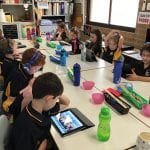
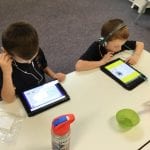
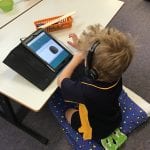
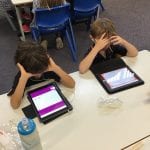

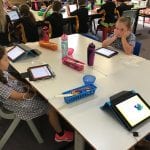
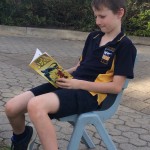
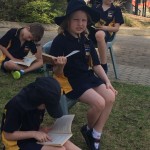
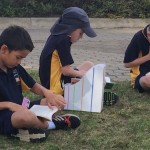
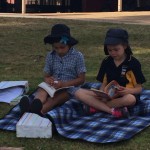
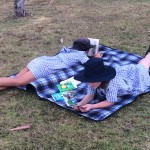
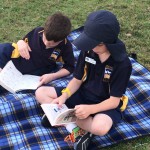
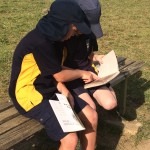
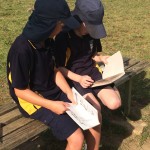
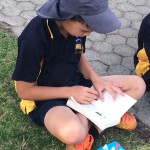
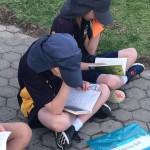
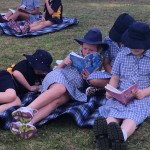
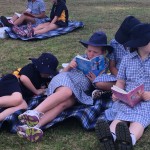
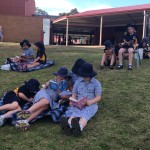
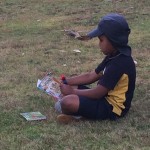
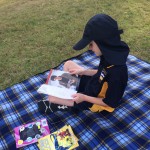
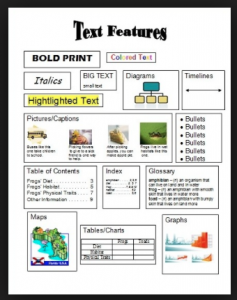
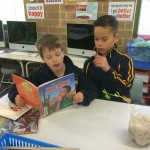
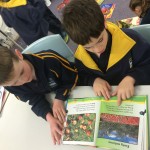
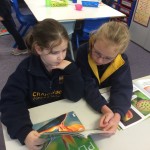
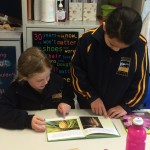
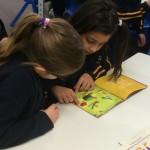
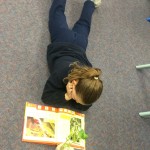
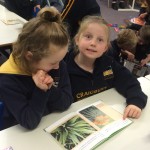
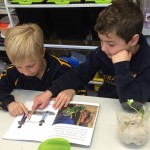
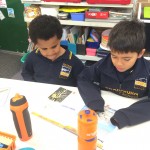
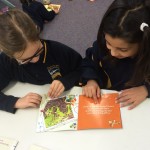
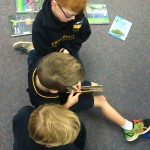
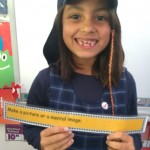
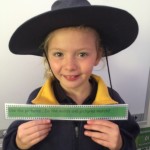
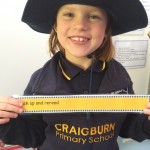
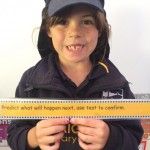
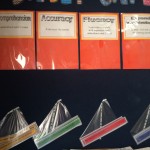
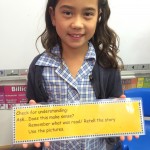
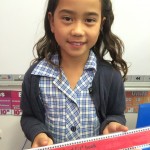


































































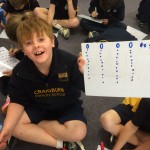
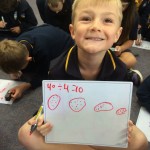
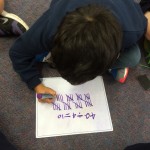
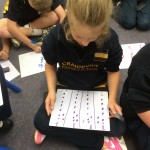
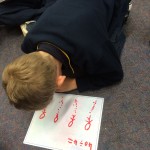
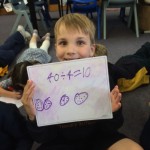
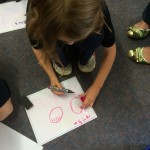
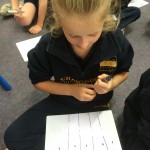
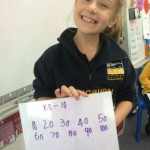
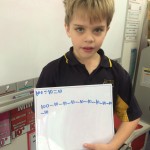
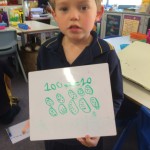



















































































I like the stars on the slide show and I like the bunny
ears and I like the big glasses.
Wow What great photos of your class reading looks like some people are on novels wow and I like the settings and the blue bird
Sorry I forgot Amelia was in your class I am amelias Friend
Love the “Magic Bed” pictures, but even more, I love those big rabbit ears and googly glasses! Very stylish indeed!
well done Brodie.
Wow awesome pictures from the magic bed! and the miniscules are funny
I really like the slideshows and length mind maps
Looks like everybody likes read and making sure that it is a good fit book.
Cool. Paul nice certificate
I like your certificates Sam and Harry.
I like the myself pics
I like the photo peach slide show
I like the magic beds story they are fantastic. they look like reel.
I like the magic beds story they are fantastic. they look like reel.
Me again! Hello!
I like that Wormie at the Beach Stories-I even like mine!
That’s it now-but there’s two more!
Paul
I like pictures the of myself.
I like the “I like myself!” book because it is all about myself. I like books about myself.
I like the slideshow
Congratulations Brodie Harry Paul Sam and other people who has earned more certificates from Jordan (f)
Great work! The “I like myself” artworks were really impressive. Everyone has such neat handwriting and is so creative!
Fantastic idea with ” self portraits ” very important learning curve as well as being lots of fun.
Layla did a very good job of reading Mitchell’s minuscule story to her little brother.
Well done to the children who got mathletics awards ,My girls love going on that site,there is often a race to get on it first
Cooper and classmates It is lovely to share your achievements keep up the good work.
wow a lot of good work from all the class like the vidos!. good to show the talent in the class. very pleased with coopers work.VERY GOOD!!!!!!
I like what you are doing in your class room.
I had real trouble finding your blog, but I’m glad I took the time to look. It’s great the work you are doing. We are very proud of you Trent.
Congratulations Brodie on getting a mathletics certificate.
Amelia loves doing Talk-Time box. She thinks hard about her clues and tries to trick you!!!
I (Brodie’s Mum) see Brodie measuring his head. So how big IS your head Mr Warncken?
I am really impressed by all the great work your class has done over the year. I especially love the bucket reading. Well done everyone!
Sophia Graham
Just gotta luv the buckets. Ingenious idea. Also will double as spare washing tubs for Ms. Sporn during the holidays.haha. Keep up the Great Work Everyone. Reading is a Skill you will have, for your whole LIFE. Work hard and embrace the LOVE of Reading. 🙂
ella’s mum BEC
fantastic reading Ella and Amelia i can see why you liked the book lots of fun. Great expression great work fabulous team work..
Really enjoyed your story Ella and Amelia. Made me feel like eating some cookies. Great Job.
and lovely reading girls….
Deb.P.
Hi Ella and Amelia great job ella and Amelia your reading was great from Katie:)
Hi well done Cooper f for getting mathematician of the day you should be proud of your work and yourself from Sam 🙂
Hi Miss Sporn.
Last Saturday, I have been doing Mathletics. Some of the tests are hard. Have you set me a test yet?
Anyway, there is a challenge called World Maths Day, World Spelling Day and World science day.
It is a good challenge for us.
Cooper F-Well done for getting the Mathematician of the day badge.
Have a nice day everyone.
From Paul
Hi miss Sporn’s class I love the bankers game and it is really fun what was your high number you got up to? Our highest was 400 or 500 or 600 but I only got 200 from Sam
good work on the very angry farmer its so good how did you get the
idear
Libby I agree with Chloe. Great job on writing your own books. I think they are very detailed.
Your Blog is really great you guys and girls are working really hard.
I love doing English and Maths because it is fun doing reading to someone. It is a good way to exercise your brain.
I love learning about German because you get to learn about a diffrent language. And you can learn about how different things they do in there life.
Tania (Siennas Cousin) I think I would love to come and work in your classroom, it looks like it would be so much fun.
I like English the best. I like writing stories with animals in them.
It is lovely to see how creative you all are. I loved your puppets and the story maps that you have all made.
I liked the very cranky bear because it had a hero in it and the sheep listened carefully and shaved half of his wool to give to the cranky bear and then the cranky bear wasn’t cranky anymore.
English and mathes are one of my favourite subjects at school. My favourite subject is spelling. It’s because I love writing because I like thinking in my head and concentrateing without talking I like the room to be quiet.
Hi! I love reading to, thats why im great at reading I also love to read Diary of a wimpy kid its so funny. I even read Pride and Prejidice thats a really long book.